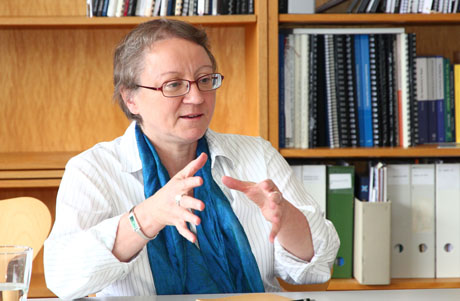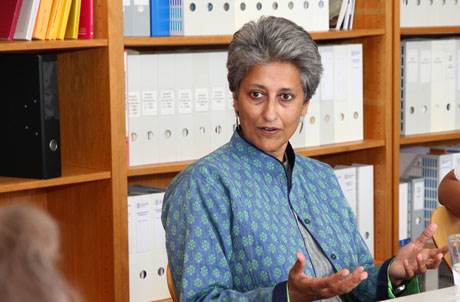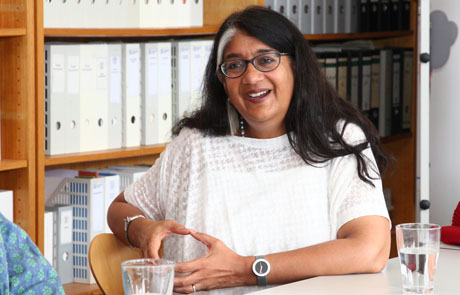The Rise of Religion
The “23rd European Conference on South Asian Studies” (ECSAS) was hosted from July 23 to July 26, 2014 at the University of Zurich by the Departments of Geography and Indian Studies, along with the URPP Asia and Europe. Some 500 scholars working on South Asia participated in this successful event at which more than 400 papers were presented.
The keynote speech by Professor Ratna Kapur (Jindal Global Law School) dealt with the growing influence of religion on Indian politics and law. The popularity of Hindu nationalist parties during the last two decades, especially of the Bharatiya Janata Party (BJP, ‘Indian People’s Party’), and their assertion of “Hindutva,” an interpretation of Hinduism in the name of the country’s “Hindu majority,” endangers the rights of religious minorities, she argued. Under the pretext of defending India as a secular state, the Hindu Right is trying to introduce a so-called uniform civil code, which would replace the current plurality of religiously based personal laws for members of different communities.
The following excerpts are taken from a discussion following the keynote between Ratna Kapur, Angelika Malinar (Institute of Asian and Oriental Studies/participating professor at the URPP Asia and Europe), and Shalini Randeria (Graduate Institute of International and Development Studies, Geneva/research associate at the URPP Asia and Europe).
Angelika Malinar: Ratna Kapur, you opened your keynote with the line: “Now God is out of the closet.” On the one hand, my immediate reaction was: “Was God ever in the closet?,” given the perception of India—at least for people dealing with issues of religion coming from the West like me—as a country with a long-standing tradition of religion. On the other hand, religion seemed to me, especially in metropolitan centers like Delhi, as being perceived as if fading out eventually in a further dissemination of secularist values. Would you say that the actual importance and growing politicization of religion was underestimated by intellectuals and academics both in the West as well as in India?

Ratna Kapur: In America, in Europe, or in a postcolonial liberal democratic country like India, we can speak about God and religion quite openly, but many progressive people, who assume themselves to be liberals and feminists and define themselves as secularists, consider these as private matters, which they do not really care about. So they have not engaged with the rise of religion seriously as part of the public discourse today especially as they saw the religious Right way back in the 1980s as people who would simply go away if we just kept on chanting the mantra of secularism over and over again. I think that was a deeply flawed strategy.

Shalini Randeria: You are absolutely right. The politicization of religion and the dynamics it could and would assume was seriously underestimated by all of us then. I think this miscalculation was also based on a certain misreading of Western secularism. Indian liberals and secularists, for instance, overlooked the role religion still plays in public life in Europe and the US. And they ignored the wide variety of secularisms in the West. Unlike Indian universities, which have no departments of Hindu or Muslim theology, all German and Swiss universities have faculties of Catholic and Protestant theology as well as religious studies/comparative religion. Britain, for instance, is very differently secular from Germany. In Germany and Switzerland, the state levies a church tax on all citizens belonging to a denomination on behalf of the churches. Most Oxford and Cambridge colleges have chapels and students return to their former college chapels to wed.

Kapur: In the United States too, religion plays an important role, although the USA is seen by many as epitomizing the wall of separation between religion and state. But every presidential candidate has to prove his faith credentials if he is to have the slightest chance at the ballot box. And think of all the cases around school prayer or around Sunday closing laws or the display of the Ten Commandments in government legislative buildings. The omnipresence of religion in the US has never been acknowledged in that model of secularism and was also largely ignored in Indian discussions about the secular.
Randeria: In European countries, Christianity, the religion of the majority of the population is imperceptibly interwoven with the fabric of everyday life. It is public visibility of the religion of the migrant minorities that stirs controversy as in the case of the ban on minarets in Swiss cities. Crucifixes adorn classroom walls in southern Germany. And when some parents filed a court case objecting to this, they were told that crucifixes aren’t a religious but a cultural symbol. Interestingly, this is the very same argument that the Hindu Right Wing party in India makes when it insists that Muslims must accept Ram, who should not be seen as merely a Hindu God but a cultural symbol on the Indian subcontinent. To my surprise as a student in Germany, I discovered that the academic system has merit-based scholarships that are given either through foundations affiliated with political parties or with the Catholic and the Protestant Church. Either would be unthinkable in India as it would be considered to be a violation of secular principles. It was only during the recent controversy surrounding the then Catholic bishop of Limburg, Tebartz-van Elst, who spent millions of Euros on renovating his residence that most people realized that his misconduct was subject to church law and not to state law. Similarly, the church as an employer of teachers, doctors and nurses in confessional kindergartens, schools or hospitals has the right to impose its own norms, which may vary from those applicable to employees in similar public institutions. While this kind of legal pluralism present but hidden from public awareness due to its association with the majority religion and its institutions, in India religiously based legal pluralism is a hotly debated issue as the current controversy on a uniform civil code once again shows.
Malinar: The extent of state involvement in the administration of religious institutions in India only became clear to me when I started my research in and on Hindu monasteries in Orissa. I heard about all sorts of state interventions, state-controlled endowment commissions, and court cases on the right of religious communities to manage their own affairs. Most strikingly, all these monasteries can be at any time transformed from a private charity trust into a public institution, which will then be administered by the state—something that would be unimaginable in Germany. State administration of the Cologne Cathedral would be, at the moment, unthinkable. Yet, the treatment of religious institutions by Indian authorities is also quite disparate. At the local level, there are massive bureaucratic interventions in religious institutions, but more generally, the state upholds its secularist framework. Concerning education, the state increasingly leaves the field open to religious communities, which establish private schools and thereby get the opportunity to extend their influence even if they follow the curricula in force in public schools.
Kapur: I totally agree with your perception of the state’s ambiguous behavior. The interventions in religious institutions are often attempts to get hold of their financial resources. There is so much money going into these institutions and the government tries to have its share. The restraint in respect of the privatization of education has a lot to do with neo-liberalism and with the withdrawal of the state from the provision of public services. And it has shifted these public tasks into the lap of private actors. Right-wing organizations like the Vishva Hindu Parishad (‘World Hindu Council’) have seized the opportunity and set up local schools to foster a process of indoctrination. Hindutva, which was articulated by the early ideologues of the Hindu Right in the 1920s, comprises the idea of establishing India as a Hindu state, has been the governing ideology of the Hindu Right and is being aggressively pursued through these indoctrination tools. Hindutva regards religious minorities as untrustworthy, as their fealties lie elsewhere, in Mecca or Rome. It also sets up one supreme god, Ram, and the demand for a supreme temple, at Ayodhya which is declared to be the birthplace of Ram, as the core components the faith of Hindus. This monotheistic approach to Hinduism is ironically inspired by Christianity and Islam. The whole Hindutva ideology is based on an invented tradition, that is thoroughly modern and Abrahamic.
Malinar: When I did my research on monasteries, I lived in a milieu that was part of a Krishna tradition. To my question, what they thought about the contemporary discourse on Hindutva, one monk said to me: “There is no space for a god with a flute (i.e. Krishna) right now. It’s a time for the god with a sword (i.e. Rama).” In my opinion, this kind of closing the ranks against other religions is part of a unification process you can find in contemporary Hinduism.
Randeria: The conservative tendencies within all religious communities today all over the world are challenging the achievements of the past decades in the sphere of women’s rights, too. It won’t come as a surprise if there is under the BJP government of Prime Minister Modi a backlash on women’s rights and the little progress made on gay rights so far.
Kapur: I think when the Delhi High Court [1] ended the criminalization of homosexuality in 2009, the time was ripe for this decision because public opinion had changed and become much more open with regard to this subject. The decision was not a big human rights victory, but a step in the right direction. In 2013, the Supreme Court gave full rights to transgenders. To me, these decisions represent a new trend. Even the BJP government never appealed against them, because there is nothing to be gained by fighting against the rights of LGBTs. The Hindu Right focuses instead on the implementation of a uniform civil code, as well as the removal of Article 370 in the Constitution that accords special status to the state of Jammu and Kashmir. I believe the LGBT groups should participate in the uniform civil code debate to fight for a gender-just family law, which allows same-sex marriages or alternative family relationships, for example. The whole debate is seen as a conflict between Hindu and Muslim interests, but, in my opinion, LGBTs’ and women’s rights are in danger too. When it comes to the protection of women’s sexual integrity, most conservative groups, regardless of their religion, are utterly opposed to them, even more opposed than to rights for homosexuals.
Randeria: The Indian women’s movement will probably not find much support from its counterparts in Europe and the US as here too women’s movements are no longer as strong as they used to be.
Kapur: Yes, these transnational alliances are really difficult to maintain. But within India, I have seen some encouraging developments: Feminists organized the “Slut Walk” and the “Pink Panty Campaign,” when women were attacked on the basis of the dresses they were wearing and what they were drinking. Although the feminist movement is diminished and feels under siege, it will perhaps find its place in more institutional forms. Some of the newer gender studies departments are doing some really exciting work now and maybe the feminist movement will take on a new incarnation. Above all, it is important to sustain the struggle. The struggle is an ongoing as India is transitioning into a neo-liberal economy and is now headed by the BJP, which is unlikely to surrender its ideology of Hindutva. New strategies are required to address this phase, and progressive groups need to rethink their forms of engagement in order to remain relevant.
[1] Naz Foundation v. Govt. of NCT of Delhi, 160 Delhi Law Times 277 (Delhi High Court 2009).
(Asia & Europe Bulletin, 4/2015, pp. 7–9)